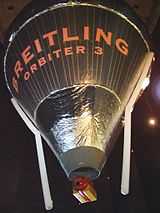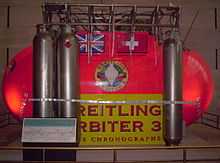Breitling Orbiter

Breitling Orbiter was the name of three different Rozière balloons made by Cameron Balloons to circumnavigate the globe, named after the sponsor Breitling. The first two balloons never completed the circumnavigation, while the third made a successful attempt in March 1999 thereby reaching the milestone of the first nonstop flight around the world by balloon (Bertrand Piccard and Brian Jones).[1]
Breitling Orbiter 3
 Breitling Orbiter 3 side view | |
Balloon | |
|---|---|
| Height: | 55 m (180 ft) inflated |
| Fuel: | Propane |
| Type: | Rozier balloon |
| Model: | Cameron R-650 |
Gondola | |
| Height: | 3.1 m (10 ft 3 in) |
| Length: | 5.4 m (17 ft 10 in) |
| Weight: | 2,000 kg (4,400 lb) empty |
| Material: | Kevlar and carbon fiber composite weave |
| Cabin Air: | nitrogen-oxygen mixture |
| Cabin Pressure: | 3.5 psi at altitude |
| Manufacturer: | Cameron Balloons, 1998 |
| Location: | Gondola: National Air and Space Museum, Milestones of Flight Gallery |
 Breitling Orbiter 3 end view | |
Breitling Orbiter 3 was the first balloon to fly around the world non-stop, piloted by Bertrand Piccard and Brian Jones. Designed and built by Cameron Balloons, of Bristol, England, Breitling Orbiter 3 stood 55 m (180 ft) tall when fully inflated. The propane gas that fueled its six burners was contained in 28 titanium cylinders mounted in two rows along the sides of the gondola. Concerned about fuel consumption, the team added four additional propane containers prior to take-off; these additions proved necessary to complete the trip.
The gondola is on display in the Milestones of Flight Gallery at the National Air and Space Museum in Washington DC, while the envelope was displayed at the Gasometer Oberhausen in Germany between 2004 and 2006.
Balloon
The Breitling Orbiter 3 was a Rozière balloon, which combines the features of a hot-air balloon and a gas balloon, with a helium cell within the hot-air envelope. Initially, the helium cell is filled to approximately 47% of its maximum capacity. During ascent, warming by the sun, and the drop in atmospheric pressure, cause the helium to expand, which in turn aids the balloon in gaining altitude.
Gondola
The Breitling Orbiter 3 gondola was constructed of a weave of Kevlar and carbon fiber material. After take-off, the cabin was sealed at 1,800 m (6,000 ft) to trap the air within it. During the flight the cabin atmosphere was supplemented by nitrogen and oxygen; carbon dioxide was removed by lithium hydroxide filters. Cabin pressure was maintained at around 3.5 psi by adding oxygen and nitrogen to the cabin air as necessary. At 10,000 m (33,000 ft), the cabin pressure equaled atmospheric pressure at 3,000 m (10,000 ft). Solar panels suspended beneath the gondola recharged the on-board lead-acid batteries that provided electrical power. Satellite-based systems enabled the crew to navigate via GPS as well as communicate.
Flight
Bertrand Piccard and Brian Jones took off from the Swiss Alpine village of Château-d'Oex at 8:05, GMT, March 1, 1999. They traveled southwest over the Mediterranean and swung east over Mauritania on March 2 at a starting meridian of 9 degrees, 12 minutes west. They landed in the Egyptian desert after being aloft 19 days, 21 hours, and 55 minutes on March 21, 1999, having traveled a distance of 40,814 km (25,361 mi). During the course of the flight, the balloon had climbed to altitudes of up to 11,373 m (37,313 ft), and achieved speeds up to 161 knots. The official "finish line" of the circumnavigation occurred over Mauritania at 4:54 AM, EST on March 19. The goal of ending in Egypt had been to touch down near the Great Pyramids; however, high winds forced the pilots to land short of their target about 80 kilimetres north of Mut. On board, they carried a copy of Guy de Maupassant's A Life, which had been inscribed by Maupassant to Jules Verne, who had imagined such a flight in his novel, Five Weeks in a Balloon. The book had been loaned to the pilots to carry for good luck by a grandson of Jules Verne from the novelist's personal library.[2]
The daily routine called for each man to spend eight hours alone at the controls, eight hours working with his crewmate, and eight hours in the single bunk. A unique pressure-operated toilet was included in a curtained off area at the rear of the craft. Despite the use of heaters designed to maintain a cabin temperature of 59 °F (15 °C), temperatures occasionally fell so low at night that drinking water froze and ice had to be carefully chipped away from delicate electronic circuitry on the interior walls.
When asked by reporter Howard Schneider about the fate of Breitling Orbiter 3, the project manager Alan Noble remarked that the sponsors and the team "...would probably donate the craft to a museum. Possibly the National Air and Space Museum or the Smithsonian."[3] In fact, that is where the gondola now resides: on the ground floor of the National Air and Space Museum in the Milestones of Flight Gallery, next to the Wright Brothers 1903 Flyer, Charles Lindbergh's Spirit of St. Louis, the Mercury Friendship 7 capsule, the Gemini IV capsule, the Apollo 11 command module, and Space Ship One. The envelope was temporarily on display at the Gasometer Oberhausen between 2004 and 2006, with a mock-up gondola.
References
- ↑ FAI entry of the record
- ↑ Associated Press, "'Grandiose' Trip Ends: Balloonists tough down in Egyptian desert", March 22, 1999
- ↑ Howard Schneider, "Earthbound but on Cloud Nine", The Washington Post, March 22, 1999,
See also
External links
| Wikimedia Commons has media related to Breitling Orbiter 3. |
- Brian Jones' personal website for the orbiter project
- BBC NEWS: Life inside Breitling Orbiter 3
- National Air & Space Museum page for the orbiter